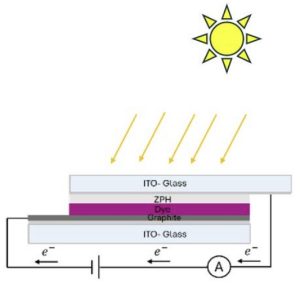
ZPH Films: A Platform for Scalable Optoelectronics & Photovoltaics
OTT1828
Applications
- Photovoltaics: Flexible, low-cost modules for data centers, EV infrastructure, rapid deployment
- UV Optoelectronics: Solid-state emitters, detectors, and sensors for diagnostics and biosensing
- Photonics & Plasmonics: Integration into switches, lasers, and self-powered sensors
Target Problems
Most optoelectronic materials are costly, rigid, or difficult to scale. Silicon PVs dominate but deploy slowly and depend on overseas supply chains. UV-emitting materials are also expensive and complex. A scalable, multifunctional material is needed for domestic energy and sensing applications.
Solution: Zinc-Phosphate-Hydrate (ZPH) Polycrystalline Films
PH films are hydrated semiconductors offering low-cost, solution-based fabrication with strong UV-visible properties. They grow directly on metal or semiconductor substrates and pair with organic dyes to enable photovoltaic cells, UV photodetectors, and light-emitting devices.
Key Benefits
- Scalable & Flexible: Low-temp hydrothermal growth; compatible with roll-to-roll and curved surfaces
- High UV Performance: Narrow-band PL at ~378 nm; dye-sensitized cells up to 281 mV Voc
- Multifunctional & Robust: Supports sensors, emitters, and energy harvesting; mechanically and chemically stable

Watch this video to learn more!
More About This Technology
ZPH films are layered, hydrated zinc phosphate semiconductors fabricated via low-cost hydrothermal synthesis. They exhibit strong UV–visible photoluminescence and semiconductor-like charge transport. When interfaced with organic dyes, they form Type II heterojunctions that promote efficient charge separation and collection, enabling photovoltaic and photodetector operation. The films function in both dry and wet cell configurations, demonstrate zero-bias response, and can be integrated onto varied substrate geometries through scalable processing.
Stage of Development
Prototypes of ZPH-based photovoltaic and photodetector devices have been fabricated and tested. Current efforts focus on improving crystallinity, reducing thickness, and increasing efficiency.
Partnering Opportunity
The UWM Research Foundation seeks partners to co-develop ZPH-based devices for energy, sensing, and photonics.
Intellectual Property
Protected under patent applications filed with the USPTO. Managed by UWM Research Foundation, which works closely with partners to support commercialization.
Inventors
Nikolai Kouklin, PhD, UWM Professor, Computer Science
Konstantin Sobolev, PhD, UWM Professor, Civil & Environmental Engineering
Please contact the UWMRF team to share your business’ needs and learn more.
